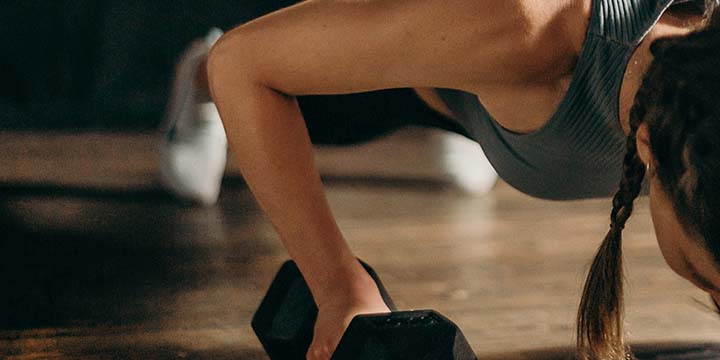If you’re in a pinch and want to get one of the most effective chest and triceps burns imaginable, try applying the Tabata protocol to the humble push up – you may be surprised at how effective this is!
When you apply the Tabata protocol to push-ups, you perform as many push-ups as you can in 20 seconds, then rest for 10 seconds. You repeat this cycle for eight rounds, for a total of four minutes. The key to Tabata training is to perform the exercise at maximum intensity during each 20-second interval.
In this article, we’ll explore what Tabata push-ups are, how to perform them, and the benefits of adding them to your workout routine.
What are Tabata Push Ups?
We all know that push-ups are one of the most effective exercises for building upper body strength and endurance. And when it comes to high-intensity workouts, Tabata training is one of the most efficient and effective ways to burn fat and build muscle.
So what happens when you combine push-ups with Tabata training? You get Tabata push-ups – a powerful workout that takes barely any time at all.
Tabata push-ups are a variation of high-intensity interval training (HIIT) that combines the classic push-up exercise with the Tabata protocol. The Tabata protocol is a method of training developed by Dr. Izumi Tabata, a Japanese researcher, in the 1990s.
It involves performing an exercise at maximum intensity for 20 seconds, followed by a 10-second rest period, repeated for a total of eight rounds or four minutes.

How to Perform Tabata Push Ups
To perform Tabata push-ups, follow these steps:
- Start in a plank position with your hands shoulder-width apart and your feet hip-width apart.
- Lower your body down by bending your elbows until your chest touches the ground.
- Push your body back up to the starting position.
- Repeat steps 2 and 3 for 20 seconds.
- Rest for 10 seconds.
- Repeat steps 4 and 5 for a total of eight rounds or four minutes.
This workout is deceptively difficult, and it can be tough to maintain a full range of motion throughout the session. If you find yourself slowing down, resist the urge to begin performing half-reps.
Keep your core engaged and your body in a straight line from your head to your heels. If you’re unable to perform push-ups on your toes, you can modify the exercise by performing them on your knees.
Benefits of Tabata Push Ups

A quick way to build strength and muscular endurance
Push-ups are a great exercise for building upper body strength and endurance. The Tabata protocol simply allows us to sneak a lot of reps into a very compressed time frame, which has the effect of creating a lot of mechanical tension on the muscles.
The reason this works so well is that we’ll be at or near muscular failure for the majority of the four minutes. If you complete all of your reps at maximum intensity with a full range of motion, you’ll quickly feel become taxed.
This means that you’ll notice hypertrophy, strength improvements, and muscular endurance improvements if you are consistently doing this workout. I would recommend at least two times per week to see results.
Burns fat and improves cardiovascular health
Despite the fact that we are doing an upper body exercise here, Tabata training is known for being a high calorie expenditure protocol. Your heart rate will be through the roof when the session is over, leading to many of the same fat burning effects you’d expect from any normal HIIT style training session.
Tabata training is a form of cardiovascular exercise that can improve your heart health and lung capacity. If you perform this style of workout regularly (perhaps by switching the exercise day by day), you will increase your cardiovascular endurance and improve overall fitness.
Extremely time efficient
Tabata push-ups are a quick and efficient way to get a full-body workout in just four minutes. Whether you’re short on time or looking to add an extra challenge to your workout routine, Tabata push-ups are a great option.
No equipment necessary
Perhaps this goes without saying, but if you’ve got a timer and a floor, you can do this workout. That’s the beauty of a simple training session like this: it can be done at home, at the park, in a hotel room, wherever you want!
Push-ups require no equipment, making them a convenient and accessible exercise for anyone, anywhere. All you need is a flat surface to perform the exercise on.
Tips for Performing Tabata Push Ups

Start slow
If you’re new to Tabata training (or push ups in general), start slow and work your way up. Remember that progress comes from consistency, not from a single all-out training session.
Begin by performing one or two rounds and gradually increase the number of rounds as you build strength and endurance.
Focus on a full range of motion
Proper form is essential for getting the most out of the exercise and avoiding injury. Keep your core engaged and your body in a straight line throughout the exercise. If you find yourself losing form, take a break and resume the exercise when you’re ready.
Mix it up
You will definetely accumulate a lot of fatigue during this workout. In order to keep going, don’t be afraid to experiment with different types of push ups.
For instance, if you feel your triceps being fried during the session, switch to a wide grip push up for the next set. If you feel your chest giving out, switch to a diamond push ups for the next set. If you’re so fatigued that you feel you can’t keep going, switch to a knee pushup.
Listen to your body
As with any exercise, listen to your body and adjust the intensity or number of rounds as needed (especially the first couple times you try this). If you feel pain or discomfort during the exercise, end the session for the day.
Remember that fitness is a marathon, not a sprint; driving progress from the session is more important than following the protocol to the letter.
Supplement with rest and recovery
Tabata training is a high-intensity workout that can take a toll on your muscles and joints. To prevent injury and promote recovery, make sure you’re recovering from session to session. Don’t do this every day, especially in the beginning!
If you’re tempted to try doing a Tabata session every day, switch body parts every day to give your body a rest. For instance, do Tabata push ups on Monday and Thursday, Tabata rows (on a towel, rings, or resistance band) on Tuesday and Friday, and Tabata squats on Wednesday and Saturday.
In conclusion
Tabata push-ups are a powerful exercise that can take your fitness to the next level. By combining the classic push-up exercise with the Tabata protocol, you can burn fat, build strength and endurance, improve cardiovascular health, and get a crazy upper body pump in just four minutes.
Whether you’re a beginner or a seasoned athlete, Tabata push-ups are a convenient, accessible, and effective way to challenge your body and achieve your fitness goals.





















